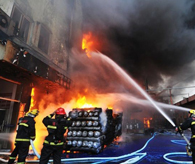The issue of fire is very important for our country and the world in terms of loss of life and property. Almost every day somehow fires occur which cause serious damage to homes or workplaces. This disturbs every part of the society in terms of its material and spiritual dimensions.
In spite of everything, the first wish is that there are no fires. However, although technological measures and technical measures that prevent the emergence of fires to prevent the introduction of the number of days are increasing. Even today, we see that we cannot prevent fires from coming out.
In that case, it is a social necessity to take measures against fires and to intervene fires in a conscious way and to make them extinguish with the least damage. The way to achieve this also requires awareness. Every job is undergoing training. All kinds of activities that will ensure social awareness in the field of fire safety at the beginning of emergency events will benefit in every sense. As a matter of fact, waiting for everything from the fire brigade is insufficient.
Therefore, all costs for fire safety should never be wasted. No expense is more valuable than human life. In this respect, even if there is no obligation to fulfill the provisions of the regulation, the safety of goods and life should be considered. Insurance should not be considered as an alternative to fire safety.
Causes of fires
Ignorance: Errors made by not knowing enough about the properties of the tools, materials and materials that we use during the production process,
Uncertainty – Negligence: In case we know the hazards that may occur, not taking the necessary measures in a timely manner, postponing them, preparing the environment to create the conditions of the fire, not complying with the warning information, not performing the necessary maintenance and controls,
Inattention: Not to be aware of possible dangers, to take seriously or to ignore,
Accidents: Fires resulting from unintentional events,
Bounce: Fires or fires for the purpose of exploitation is out of control. You can burn picnic fires, stubble or scrap.
Natural phenomena: Lightning falls, sun rays, wind and rashes, decay, etc.
Sabotage: It is a fire that has been removed for the purpose of harm.
Combustion, Fire and Prevention Methods
Combustion of solid, liquid or gaseous substances in an oxygen-containing environment with heat entering the chemical reaction is called the chemical reaction. It is called fire by turning out of human control of burning and turning into disaster.
It is necessary to start and drive combustion; The combustion triangle (fuel), combustor (oxygen), and ignition (ignition source) are called combustion triangles to come together in proper conditions. In the absence of any of the conditions or in sufficient quantities, the combustion does not occur. Extinguishing is carried out by eliminating at least one.
FIRE, In the first stage of POPs, in the second stage SMOKE, in the third stage FLAME is seen.
They are classified according to the physical properties of flammable materials in fires. Each class fire shows different burning characteristics. The four main fire classes are basically described. These are respectively;
Class A: SOLID FIRE: Fires resulting from combustion of flammable solids leaving carbon layers. (Wood, coal, paper, etc.)
B-Class: LIQUID FIRE: Flammable liquids, petroleum products are produced by the ignition of liquids. (Gasoline, diesel, machine oils, oil paints etc.)
C-Class: GAS FIRE: Fires resulting from flammable gases. (Methane, propane, butane, LPG, natural gas, acetylene, hydrogen etc.)
D-Class: METAL FIRES: Magnesium, Aluminum, Sodium, Potassium, such as fire ignited by light metals.
The principles of extinguishing are common, regardless of the class of fire. This principle is to eliminate flammable material, oxygen or heat from the three elements that make up the combustion.
Elimination of flammable material: Although it is possible to eliminate flammable materials by breaking, splitting, or cutting liquid flow, it is not always possible to use the application if the combustible materials are heavy and immovable.
Eliminating heat: Since each combustible material has a combustion temperature, it is a good way to extinguish the burning materials to below this temperature to extinguish the fire.
Eliminating oxygen: It is necessary to deliver the aerosol liquids to the fire site with heavy and non-flammable gases, reducing the oxygen content in the air by reducing the rate of oxygen in the air.
In general, water, foam, dry chemical powder (KKT) and gas systems and sand are used as extinguishing methods. Water must not be used in flammable liquids, electrical and solid fires. KKT should not be used in metal fires. Foam should not be used in electrical and metal fires. Gas fire extinguishers in metal fires

